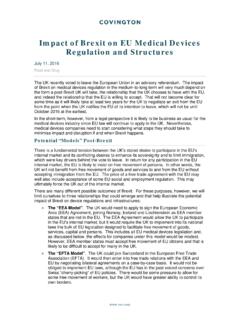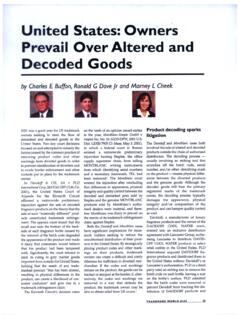Transcription of Common Islamic Finance Structures - Covington & Burling
1 DC: 6583604-1 Common Islamic Finance Structures December 1, 2017 Finance introduction What is the purpose of this note? This note is intended for clients who are largely unfamiliar with Islamic (Shari ah compliant) Finance products and interested to understand: the basic principles underpinning Islamic Finance Structures ; how those Structures differ from the conventional (non-Shari ah-compliant) financing Structures that they may already be familiar with; and what some of the most Common Islamic Finance Structures look like in concept. As a general note, in line with other law firms involved in the documentation of Islamic Finance Structures , we do not, and are not competent to, express any opinion on Shari'ah generally or more specifically as to whether any document, or the transactions contemplated therein, comply (or otherwise) with the teachings of Islam or Shari ah. What is Shari ah? Shari ah is derived from a number of sources, including the Quran, and is a non-codified body of law underpinning Islam generally and Islamic Finance as a product.
2 Because it is not a codified body of law, it is capable of development and subjective interpretation. In order to be considered Shari ah-compliant an Islamic Finance structure typically receives an opinion (fatwa) from a religious scholar (mufti) or recognised Shari ah adviser. The capacity for subjective interpretation of Shari ah means that the opinions of the specialist scholars and advisors on issues may vary, not least depending on which of the five Islamic schools of law (madhabs) that they belong to. What is Islamic Finance ? The term Islamic Finance refers to the network of financial institutions and commercial financing activities that conform to Shari ah. The following are the key prohibitions under Shari ah that are the key principles guiding Islamic Finance Structures : prohibition on usury or changing of interest (riba), with returns required to be based on sharing profit and loss; prohibition on uncertainty (gharar); prohibition on speculation (maisir); and Finance 2 prohibition on the use of or dealing with impermissible (harem) activities or commodities (such as alcohol).
3 How does an Islamic (Shari ah-compliant) financing product differ from a conventional (non-Shari ah-compliant) financing product? In terms of translating the key principles referred to above into a financing structure , the following table illustrates some key required deviations from a conventional (non-Shari ah -compliant) floating rate loan structure : Provision Conventional Financing Product Islamic Financing Product Return on principal payment Conventional financing typically levies interest on any principal advanced. The charging of interest is regarded as harem and any return on principal invested must be structured as a share of profit or a payment for a service provided. This is the fundamental driver for most Islamic Finance Structures as they cannot involve a simple advance of principal with a return on such principal calculated simply by reference to the amount of such principal outstanding (in essence, an Islamic Finance structure cannot simply allow for the Financier to earn money on money).
4 Floating rate return on principal Most conventional commercial loans require payment of a floating rate of interest, calculated in arrears based on application of a base rate ( , LIBOR) for the number of days for which the principal is outstanding over a certain period ( , three or six months) and applicable only to the amount of principal outstanding at any point in time. While return on principal invested is commonly structured in Islamic Finance Structures using a floating base rate ( , LIBOR) and is often payable in arrears at the end of set periods ( , three or six months), the prohibition on uncertainty means that the amount of return payable at the end of the set period must be structured so that it is known upfront at the beginning of the period. This requirement for certainty can lead to complexities, particularly where principal is returned mid-period or additional costs are incurred by the Finance 3 financier mid-period which it is looking to pass through.
5 Hedging floating rate interest or exchange rate exposures Many conventional commercial floating rate loans require the debtor to hedge its floating rate exposure and/or (where there is a currency mismatch between the borrower s revenue and debt payment obligations), its foreign exchange rate exposure. This is typically done separately from the principal debt documentation, under an ISDA based agreement. The prohibition on speculation (interest rate or foreign exchange rate hedging being, in essence, speculating on the direction of the respective markets) means that Islamic Finance Structures are not hedged. Underlying asset financed Subject to any issues arising under applicable law and the risk appetite of a financier, there is typically no restriction on what can be financed using a conventional product, such as a loan. Islamic financing products cannot be used to Finance any underlying asset or activity that would be consider harem.
6 Obvious examples would be the acquisition or operation of a brewery or distillery. However, this can lead to complexity when one looks to Finance a mixed use asset or business, such as a hotel or aircraft (which likely serves alcohol) or a shopping mall (where certain outlets may be considered harem, such as a non-halal butcher, a shop selling alcohol or, in certain cultures, a cinema). With these principles in mind, the rest of this note seeks to summarise some of the more Common Structures currently in use in the Islamic Finance market. Finance 4 Traditional Murabaha A traditional murabaha structure is ideal for a trade Finance situation, where a Customer has to pay for goods, but cannot immediately pay the full amount of the purchase price for the goods. A worked example looks like this: a Financier steps in and buys the goods and pays the Supplier the full amount of the purchase price, on delivery; on receipt of the goods, the Financier sells them on to the Customer (usually on an as-is-basis and usually the Financier directs the Supplier to deliver to a location nominated by the Customer, so the on-sale occurs immediately); and the Financier and Customer s payment terms are such that the Customer pays the Financier within a set time period ( , one year) either as a single payment or in staged payments on a pre-agreed schedule, together with a pre-agreed profit margin (typically calculated as an ascertainable floating base rate ( , LIBOR) + a fixed percentage) charged to reflect the Financier s risk of facilitating the purchase.
7 The structure is less suitable for transactions with payment terms linked to a floating benchmark such as LIBOR if the underlying payment period goes beyond one LIBOR period. Finance 5 Commodity Murabaha A commodity murabaha is generally considered to be the Islamic Finance structure that is closest (in terms of practical effect) to a conventional loan and typically the most straight-forward to effect (in a large part as it requires the Customer to neither want to acquire a tangible asset or be in possession of an underlying tangible asset which can be used in the financing structure ). In light of this perceived similarity to a conventional financing, not all Shari ah scholars and advisers are willing to issue a fatwa on a financing structured in this manner. Nevertheless, a commodity murabaha is arguably the most commonly used form of Islamic financing product. A commodity murabaha works similarly to a traditional murabaha, only that on receipt the Customer immediately sells the goods back into the market.
8 Unlike a traditional murabaha (where the financing is to facilitate acquisition of a commodity that the Customer actually wants), a commodity murabaha structure can be used to facilitate funds flow to an entity, even where the entity does not want the underlying commodity. The commodities are usually something traded in over-the-counter certificates in a liquid market (to ensure all ownership transfers can be effected immediately and the Customer can sell the commodity swiftly back within a few seconds of instructing the Financier to buy the assets in the first place). The only additional requirement being that the commodity is not harem. Typical underlying commodities used are warrants on the London Metal Exchange. A worked example looks like this: the Financier buys USDXm of steel from Commodity Broker A at market price. on the same day the Financier sells the steel to the Customer with payment due from the Customer within a set time period ( , one year), the price is agreed as USDXm + a pre-agreed profit margin (typically calculated as an ascertainable floating base rate ( , LIBOR) + a fixed percentage) charged to reflect the Financier s risk of facilitating the commodity sale; and the Customer sells the steel back into the market (to Commodity Broker B) at the same market price ( , USDXm) and on immediate payment terms.
9 Finance 6 The practical effect of the structure is: given that the market price on that day was USDXm, the Customer now has USDXm in cash, but an obligation to pay to the Financier USDXm, plus its profit margin; and often Commodity Broker A, Commodity Broker B and the Financier co-ordinate, so that all book entries are made nearly simultaneously and money in practice often flows directly from the Financier to the Customer with other transfers being netted-off. It should be noted that the deferred purchase price (together with profit margin) is payable in full at the expiry of each murabaha contract (which, in order to facilitate the payment of the LIBOR-based profit margin, will be at the end of what in conventional loan terminology would be the end of an interest period). While a typical commodity murabaha structure will include mechanics envisioning the parties entry into a new murabaha contract on the same terms on the expiry of the previous contract, the structure does, in effect create something akin to a conventional revolving credit facility (even if the Customer is actually looking to receive funds on a basis equivalent to a conventional term loan facility).
10 The principal issue that this gives rise to is the danger of a drawstop being triggered, requiring payment of the deferred purchase price in full without the ability to roll into a new murabaha contract. Subsequent murabaha contracts can be entered into for quantities of commodities with a reduced market value, if the intention is to replicate a conventional amortising term loan approach to return of principal. Finance 7 Ijara An ijara structure is the Islamic Finance equivalent of a conventional Finance lease. It is often used for real estate or asset financings, because it requires the availability of an underlying tangible asset. An ijara is arguably the second most commonly used form of Islamic financing product, after a commodity murabaha. A worked example looks like this: the Financier purchases title to a tangible asset owned by the Customer, or the Customer acquires a new tangible asset on behalf of the Financier (using the Financier s funds); the Financier then leases the purchased asset (back) to the Customer at a pre-agreed rent (typically calculated as an ascertainable floating base rate ( , LIBOR) + a fixed percentage) charged to reflect the Customer s use of the asset; and at the end of the ijara contract or earlier default, the Financier sells the asset (back) to the Customer (under a Sale Undertaking), or the Customer is required to (re)purchase the asset from the Financier (under a Purchase Undertaking), in either case, for an amount equal to the original purchase price plus accrued and unpaid rent.



















